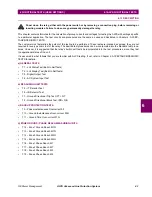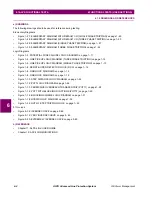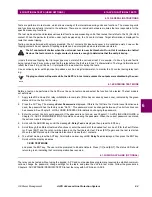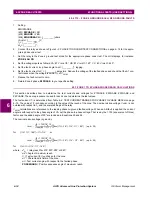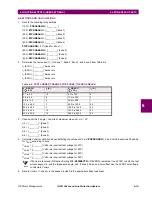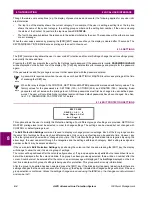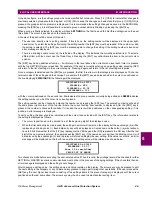
6-14
ALPS Advanced Line Protection System
GE Power Management
6.5 ZONE REACH TESTS
6 FUNCTIONAL TESTS (USER SETTINGS)
6
6.5.6 T15 – ZONE 4 GROUND REACH, M4G GROUND FAULTS
1.
Setting:
Z4DISTANCE
(401) Z4PHASE = NO
(405) Z4GRND = YES
(406) Z4GRDREACH = [_________] ohms,
V
NOM
4
= [_________] V,
I
T
= [_________] A,
øI
4
= [_________]°,
2.
Connect the relay as shown in Figure 4–3: PHASE TO GROUND TEST CONNECTIONS on page 4–12 for the appro-
priate phase under test.
3.
Set the relay to the Zone 4 ground test mode for the appropriate phase under test. The LUI displays, for instance:
ZONE 4 AG ON
4.
Set the voltage inputs as follows: VA: 67 V rms
∠
0°, VB: 67 V rms
∠
–120°, VC: 67 V rms
∠
–240°.
5.
Set the fault current,
I
op
, phase angle to
øI = [________]°, lagging.
6.
Set the fault current to
I
T
= [________] amps rms. Reduce the voltage of the faulted phase and check that the A1 con-
tact closes when the voltage is within 7% of
V
NOM
.
7.
Reduce the fault current to zero.
8.
Return Zone 4 phase, Z4PHASE, to your specific setting.
6.5.7 ZONE 1 TO 4 PHASE-PHASE REACH CALCULATIONS
This section describes how to determine the test currents and voltages for Z1PHASE, Z2PHASE, Z3PHASE, and
Z4PHASE. The same procedure is used for each zone to determine the test values.
The test current, IT, is determined from Table 6–2: TEST CURRENT RANGES FOR PHASE-TO-PHASE REACH on page
6–15. The value of
I
T
is chosen according to the value of the reach of the zone. The nominal pickup voltage,
V
NOM
, is cal-
culated with respect to
I
T
and to several settings of the relay.
V
NOM
calculations are referenced to the leading phase-to-ground faulted voltage. When an AB fault is applied, the current
angle is with respect to the phase angle of VA, not the phase-to-phase voltage. That is why the 1.732 (square root of three)
factor and the added angle of 30° are included in Equations 25 and 26.
The nominal pickup voltage is given by
for ,
or
for .
where:
Z
R
= relay reach for Z1P, Z2P, Z3P, or Z4P.
øZ = Angle of maximum reach.
I
T
= Test current for
I
op
, chosen for the zone.
øT = Characteristic timer of the zone.
øI = Test current angle with respect to the faulted phase
POSSEQANG = Positive sequence angle of maximum reach.
V
NOM
2 1.732
⁄
(
)
Z
R
I
T
⋅
⋅
90
° ∅
T
–
(
)
cos
------------------------------------------------
∅
I
30
°
+
(
) ∅
Z
–
∅
T
–
90
°
+
(
)
(eq. 6–25)
cos
⋅
=
∅
Z
∅
T
180
°
–
+
(
) ∅
I
∅
Z
<
<
V
NOM
2 1.732
⁄
(
)
Z
R
I
T
⋅
⋅
90
° ∅
T
–
(
)
cos
------------------------------------------------
∅
I
30
°
+
(
) ∅
Z
–
∅
T
90
°
–
+
(
)
(eq. 6–26)
cos
⋅
=
∅
Z
∅
I
∅
Z
∅
T
–
180
°
+
(
)
<
<


